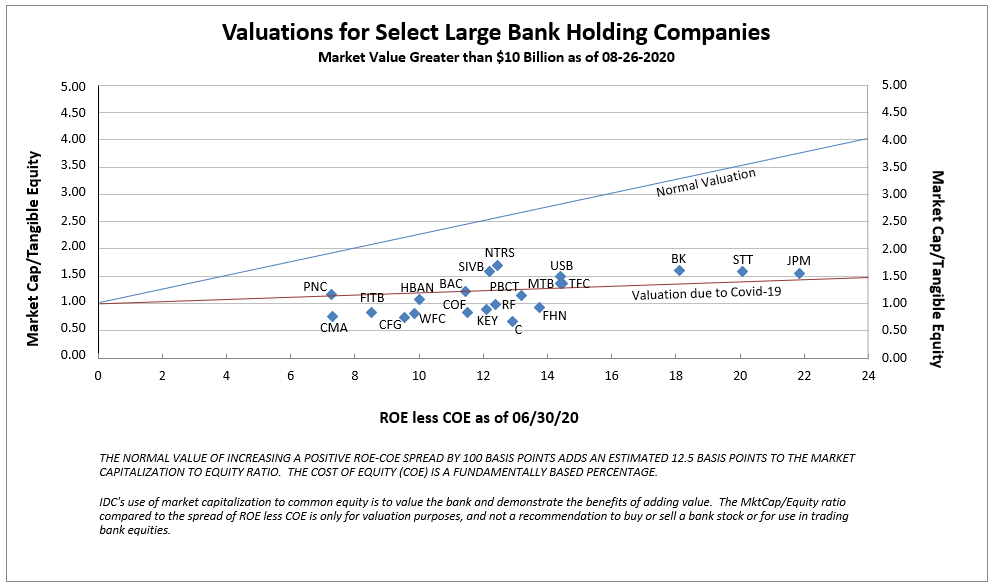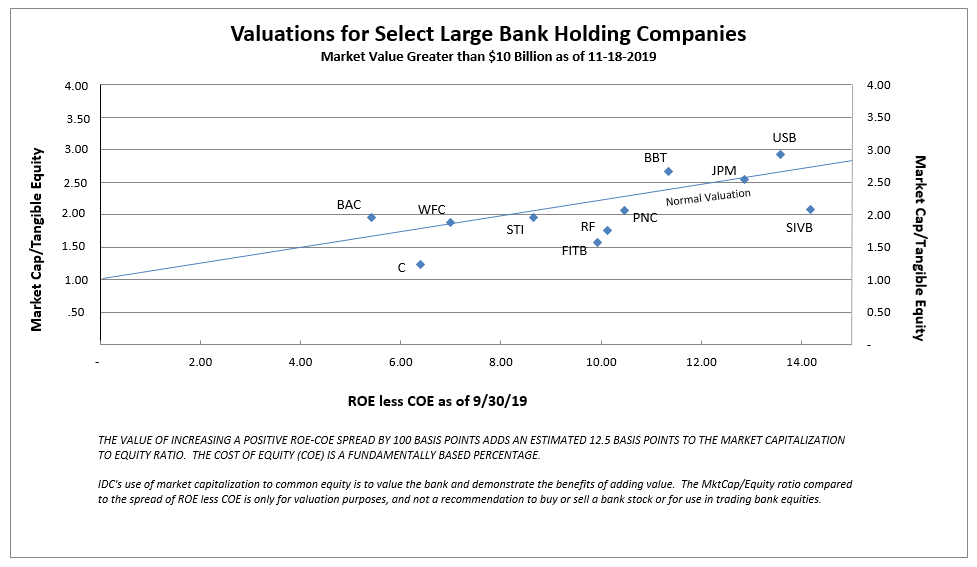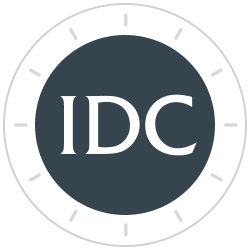The Best Indicator of Bank Stock Value is ROE vs. COE
IDC Financial Publishing (IDCFP) measures relative profitability of bank holding companies by comparing the IDCFP real return on tangible equity (NOPAT ROE) to our definition of the cost of equity (COE). Margin between ROE and COE (included in the “M” in IDCFP’s unique CAMEL analysis) is a key measure of management.
If the spread of ROE less COE is positive, or improving, management is creating value. The wider the spread, the greater the value. If the spread of ROE less COE is decreasing, or negative, management is destroying value. Bank value, in turn, is then determined by comparing its stock price to its tangible book value, i.e. equity market capitalization to tangible book value of common stock, versus the spread between ROE and COE to determine a bank’s valuation (see Chart I).
On 06/30/20 the long bond U.S. Treasury yield was 1.4% and the average COE for select large bank holding companies was 3.0%, with COE ranging from 2.36% for Capital One Financial Corporation (COF) to 4.05% for Wells Fargo Corporation (WFC). As seen in Chart I, there is a high correlation between Market Capitalization/Tangible Book Common Equity compared to IDCFP’s spread of ROE less COE for large bank holding companies. This correlation demonstrates how COE, when defined by long-term U.S. Treasury yields and bank-specific risk, best determines cost of equity capital, in comparison to ROE, and therefore the value correlation or valuation line.
Chart I

Favorable Large Bank Valuations on November 18th, 2019
To understand the normal valuation line from Chart I, we must look at the ROE from September 20th, 2019 and market valuation as of November 18th, 2019 (see Chart II). Following the August 2019 low in bank stock valuations, we saw stock valuations that performed better and led the stock market recovery from August to November 2019. High quality, large bank stocks with spreads between ROE and COE of 10 to 14 percentage points sold as high as 2.66, and as low as 2.07 times tangible book value.
These high valuations and favorable ROE less COE spreads reflected a strong and healthy economy in 2019, with an optimistic outlook for 2020 - - all pre-Covid-19. The favorable valuations also provide a blueprint of the opportunity for a healthy banking system in 2021 and 2022, following economic recovery in 2020.
Chart II

The Impact of Covid-19 on Large Bank Stock Valuations
The best valuation method compares market common equity capitalization to tangible capital (price to book) versus the spread between real return on tangible common equity (ROE) less cost of equity (COE). The latest reported ROEs are for the second quarter ending June 30th, 2020, reflecting a still-healthy banking system during the Covid-19 pandemic. The COE uses the long T-Bond yield as of June 30th plus adjusted for individual bank risk times half of the 30-year yield. The Federal Reserve cut the Fed Funds rate to zero, and the yield on the U.S. 30-year T-Bond and COE reflects that, as well as economic weakness from Covid-19. Therefore, the spread between the high ROEs and low COEs are very wide.
Low Valuations Between 0.5 and 1.5-Times Book Value Discount the Wider Spread
During the recovery phase from economic disaster caused by Covid-19:
- ROEs will recover in late 2020 into 2021 and 2022.
- COEs are expected to rise, reflecting higher yields on 30-year T-Bonds later in 2020, and especially in 2021 and 2022.
- Stable ROE and higher COE narrows the expected spread for the high quality, large banks to 10%, down from a median of 12% today.
- Valuations are expected to recover to normal levels to 2 to 2.5-times book value (see Chart I).
The Special Case for J.P. Morgan During the Period of Covid-19*
J.P. Morgan financials are particularly unique, in that the NOPAT ROE for the second quarter of 2020 rose to 25%, dramatically above the 16.7% for the first quarter 2020 and the year 2019.
What caused the favorable outcome?
NOPAT ROE includes the return on earning assets from operations (ROEA), before funding costs, adjusted for the increase in the loan loss reserve, and after tax. The sum of ROEA and return from financial leverage (ROFL) equals NOPAT ROE.
JPM ROEA rose to 1.99% in the second quarter of 2020, up from 1.84% in the first quarter, and equal to the 1.99% realized in the fourth quarter of 2019. ROEA remained stable or slightly improved. On the other hand, JPM’s ROFL rose dramatically from 14.8% in the first quarter to 23% in the second quarter of 2020. ROFL equals the leverage spread (difference between ROEA described above and the after-tax cost of funding earning assets, not funded by of equity or the loan loss reserve) times financial leverage.
Due to the Federal Reserve reducing the fed funds rate to zero, JPM’s after-tax cost of funding fell to 0.26% in the June quarter, from 0.61% in March. The leverage spread therefore rose to 1.74% from 1.23%. Given the widening of the leverage spread, and the prospect of little change in the fed funds rate for years, JPM increased the leverage multiplier to 13.2-times in June, above the 12-times in March and 11.7-times in 2019.
The leverage multiplier equals the earning assets funded by deposits and borrowings (earning assets less equity plus the loan loss reserve) divided by the sum of equity and the loan loss reserve. The combination of increased leverage to 13.2-times with the widened leverage spread to 1.74%, provided a return on financial leverage of 23%. Adding the operating return of 2% provides the NOPAT ROE of 25%.
J.P. Morgan simply took advantage of the opportunity for low borrowing costs for years in the future, increasing leverage to produce dramatically higher ROE. JPM, given control of the operating return near 2%, has the prospect to maintain this high ROE. Even with a rising COE due to higher future long-term bond yields, the valuation to tangible book value could rise to 3-times book value.
*IDCFP is not an analytical investment firm for stock market valuations. We are simply demonstrating a management strategy and how it can add value.
To view all our products and services please visit our website www.idcfp.com.
For more information about our ranks, or for a copy of this article, please contact us at 800-525-5457 or info@idcfp.com.
John E Rickmeier, CFA, President, jer@idcfp.com
Robin Rickmeier, Marketing Director
